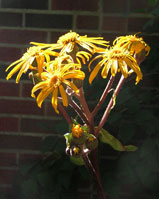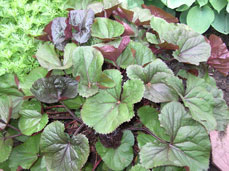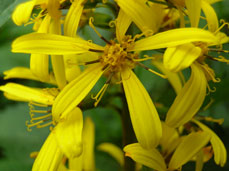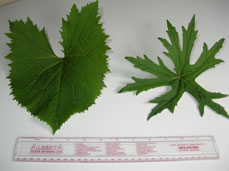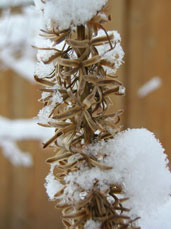This article is anticipated to appear in the CHS newsletter in 2009
|
Ligularia |
|
| Ligularia - although there are many common names for these dramatic and handsome beauties, in Calgary the usual term is the generic ligularia. They are fabulous perennials, occurring naturally from Europe across to Japan. Their virtues have been described so well in "Calgary Gardening" by Judith Doyle, in 1988 & 1995 and by Clancy Patton in 2003, and that 2003 newsletter cover shows a great photo of Ligularia przewalskii. One appealing attribute of the genus is that leaf form in particular, as well as colour, varies between varieties – and colour varies with time, deepening from red to purple in ‘Othello’, for instance. |
Ligularia dentata flowers click on images to enlarge |
|
Ligularia dentata leaves |
The huge range in leaf form includes rounded, kidney-shaped or triangular shapes that can be deeply divided or undivided, and with finely or coarsely serrated margins. The leaves can be up to 40 cm or more across. Varieties of L. dentata (‘Britt-Marie Crawford’ and ‘Desdemona’, for example) have yellow-orange daisy-like, flattish-topped, loosely branched clusters of flowers rising about a metre from mounds of broad heart-shaped leaves, whereas several other species grow up to about two metres high, and have brighter, commonly yellow flowers on spikes above highly toothed leaves. For newer, shorter, versions with unusual, attractively coloured leaves, Quebec’s Osiris gardens have recently produced varieties which should be available in 2009 in some Calgary area garden centres. |
| The attributes of Ligularias are many. They need no staking and they’re non-invasive. They have yellow or golden-orange flowers that brighten up the late summer borders – often the flowers are arranged in tall pyramids or umbrella-like sprays and individual flowers are typically about 2 to 5 cm across. The colour of the stems and the underside of the leaves is marked and usually well reported. They are tough (hardier than expected from zone designations), but look best when not exposed to intense mid-afternoon July and August sun which causes their leaves to wilt until evening brings re-hydration. Mulching helps retain soil moisture. The greatest foe here is hail, particularly with the broad-leafed varieties. They do best in deep humus-rich soil in dappled shade enriched by a light application of spring fertilizer. Calgary’s gardens can provide almost ideal conditions – our tiny "Prairie" slugs rarely bother them (I like the story from the U.K. that if you have slug problems with hostas, plant ligularia and the hostas will be safe!), and the tall forms grow taller than often indicated by growers. For me the statuesque stalks with dried petals provide winter interest too. Occasionally some varieties "truly" self-seed in a long growing season and others may cross-pollinate; all can be divided in spring. |
Ligularia wilsoniana |
|
wilsoniana & przewalskii leaves |
References ascribe the genus to the Asteraceae family or the Compositae family. The best starting point for information is the 2006 Encyclopedia of Perennials edited by Graham Rice, which describes 17 varieties, and the internet has great photos (note the identifications with the photos accompanying this text are tentative), but use references carefully. There’s some confusion with ligularia taxonomy, so some sites provide conflicting, inaccurate descriptions and images; others show flower form or leaf form only. With both old and new varieties to choose from, it’s good to shop around for your ideal form and colour. Information about hardiness, form and colour can be gained from knowing the parents of each hybrid … ‘Gregynog Gold’ (from dentata & veitchiana); ‘Rocket’ (przewalskii and stenocephala); hessei (dentata and wilsoniana); palmatiloba (dentata and japonica); ‘Zepter’ (veitchiana and the ‘Rocket’). Everyone has a niche for one plant – or perhaps even for a mass planting expanding over say five years or more. Shop early, plant in May (and mulch for protection), then just sit back and enjoy them. |
| Glynn gardens in two countries – but it’s so much easier here ! |
Ligularia wilsoniana winter |
|
Selected Ligularia varieties |
||||
|
Species |
Variety |
Height, max |
Leaf colour |
Leaf shape |
|
or hybrid |
||||
|
m |
||||
|
dentata |
Britt-Marie Crawford |
1.1 |
blackish maroon, reddish purple underneath |
rounded |
|
dentata |
Desdemona |
1.2 |
dark bronze-green, deep reddish-purple underneath |
heart-shaped, toothed, long-stemmed, |
|
dentata |
Gregynog Gold |
1.8 |
bright green |
heart-shaped, rounded, toothed, long stemmed |
|
dentata |
Othello |
1.1 |
deep purple-green, purple-black underneath |
heart-shaped, toothed, long-stemmed |
|
dentata |
1.5 |
glossy deep green above, reddish below |
kidney-shaped, coarsely toothed |
|
|
fischeri |
1.8 |
mid green |
kidney-shaped, rounded, puckered, toothed margins, |
|
|
hodgsonii |
0.6 |
mid green, leathery |
heart or kidney shaped, rounded |
|
|
japonica |
1.4 |
mid green |
deeply dissected, very pointed digits |
|
|
macrophylla |
2.0 |
dark green, huge |
banana-shaped, 60 cm long |
|
|
przewalskii |
1.8 |
dark green |
jagged, deeply toothed & lobed, triangular, irregular |
|
|
sibirica |
1.8 |
dark green |
kidney-shaped, rounded, triangular, finely toothed |
|
|
stenocephala |
Little Rocket |
0.5 |
mid green |
heart-shaped, serrated |
|
stenocephala |
The Rocket |
1.8 |
mid green |
heart-shaped, triangular, delicately, irregularly saw-toothed |
|
stenocephala |
1.5 |
mid green |
rounded, triangular, jagged |
|
|
tangutica |
1.2 |
deep green |
ovate, toothed |
|
|
veitchiana |
2.0 |
bright green |
triangular, heart or kidney shaped, wavy-toothed margins |
|
|
vorobievii |
1.8 |
mid green |
rounded, basal |
|
|
wilsoniana |
1.9 |
mid green |
rounded, sharply toothed |
|
|
x hessei |
1.8 |
mid green |
rounded, kidney-shaped |
|
|
x Osiris Cafe Noir |
0.5 |
variable, black to olive green over time |
deeply lobed, toothed |
|
|
x Osiris Fantaisie |
0.7 |
dark green, purple underneath |
rounded, toothed |
|
|
x palmatiloba |
1.5 |
mid-green, glistening |
palmate, triangular, jagged edges |
|
|
x Zepter |
1.8 |
mid-green |
rounded |
|
|
January 15th 2009 |
||||
